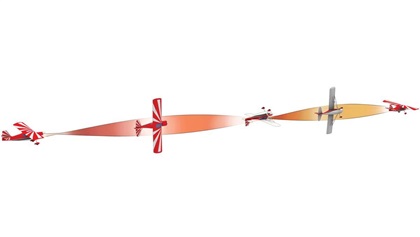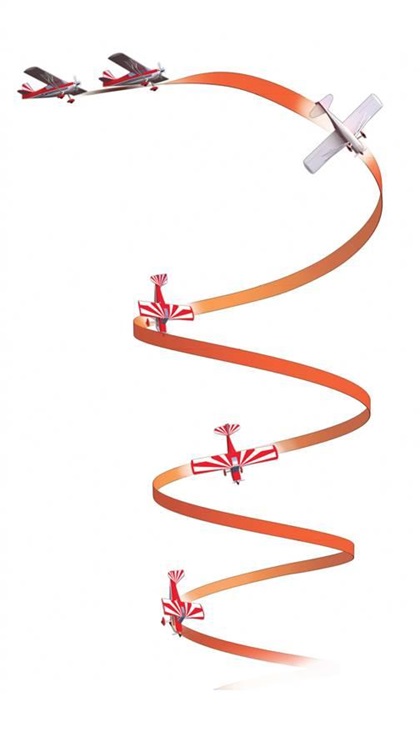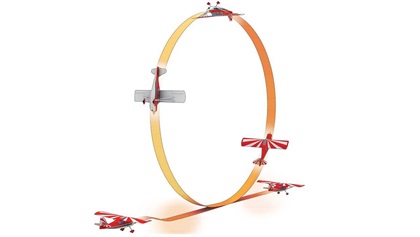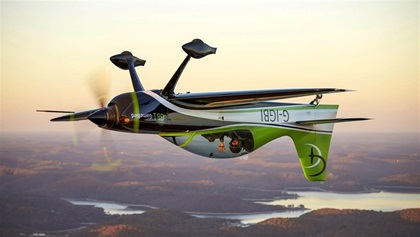Roller coaster ride
Skills, precision, safety, and confidence; the benefits of aerobatic flying

But aerobatic flight training builds and refines skills that can benefit every other aspect of a pilot’s repertoire. And those heightened sensibilities can expand performance, add confidence, and reduce anxiety across the full flying spectrum.
“Our mission is to help you become a safer, more skilled, more confident pilot and ultimately help you get more enjoyment out of flying,” says Patty Wagstaff, an aerobatic competitor and airshow performer who operates an aerobatic flight school in St. Augustine, Florida. “That’s what our courses are all about.”
The first difference in aerobatic flight training is that it encourages—demands, really—students to use sharp and decisive control inputs. Smooth, subtle, fingertip control manipulation as learned in private pilot training is out. It’s replaced by full-deflection, stop-to-stop control inputs for maximum aircraft performance.
An aileron roll in a typical aerobatic trainer requires every last inch of stick travel. Entering a spin and allowing it to develop requires pressing a rudder pedal to the floor and keeping it there as well as every bit of aft stick. Aerobatic pilots must fully commit to maneuvers—especially in trainers cursed with relatively slow roll rates and marginal engine power. (Yes, I’m talking about you, Cessna Aerobat, American Champion Citabria, and Stearman PT–17.) Similarly, typical throttle positions are either wide open or idle during aerobatic maneuvers.
The result of all this aggressive handling is a strenuous, physical flight experience. Private pilots are accustomed to the feeling of two Gs, or twice the normal force of gravity, that presses them into their seats during steep turns with 60 degrees of bank. Aerobatic maneuvers such as loops, Immelmanns, and half-Cubans typically subject students to about four Gs. And negative Gs that push the occupants away from their seats (such as during sustained inverted flight) are entirely new to most aerobatic students. These novel sensations can be fatiguing, disorienting, and exhilarating, all at once.
The payoff for aerobatic students is the knowledge that they can control their airplanes with precision throughout 360 degrees of pitch and roll and their entire speed range. The willingness to use full control deflection unlocks any aircraft’s full performance envelope. “Unusual” attitudes are no longer “unknown.” All the intimidating mystery about them disappears.
How It Begins
Aerobatic flight training brings some new accessories: a parachute and a quick-release aircraft door or bubble canopy that can be jettisoned in flight.
Most aerobatic trainers are equipped with control sticks—not yokes—so that pilots can more quickly and easily apply full deflection. Aerobatic students who have only flown with yokes may wonder whether they’ll be able to adapt to a control stick, but the transition is usually immediate. A floor-mounted stick quickly becomes second nature even to pilots new to them.
The first aerobatic maneuver that students learn is usually an aileron roll, and it’s meant to be a confidence booster. Students must use full aileron deflection and sustain it, and they see the horizon go from level, through inverted, and back to level again. The maneuver begins at cruise speed. The pilot raises the nose about 20 degrees, unloads the wings by momentarily letting the airplane draw a straight line, and then decisively adds full aileron (and coordinated rudder) and holding it until the wings are level again.
The nose typically drops well below the horizon during an “ailerons only” roll, and that’s just fine. The point of the exercise is to introduce full control deflection and flying the airplane around the longitudinal axis. Roll variations (such as slow rolls and point rolls) can come later.
Students should practice rolling both left and right during this introductory phase.
Common student errors:
- Using less than full aileron deflection.
- Becoming disoriented during the inverted phase of the roll and neutralizing the controls.
- Rolling out too early.
Hard work
Spins are the most valuable and least enjoyable part of aerobatic training.
They’re disorienting. No two spins ever feel exactly alike. And the airplane seems to get a mind of its own as unseen forces cause the spin to accelerate.
Students are typically asked to count each half-turn out loud during the spin (“half, one, half, two,” and so on). Instructors don’t really need a student to tell them the number of turns. They know. But having students count lets instructors know whether they are mentally keeping up with the airplane’s rapidly changing orientation, or if they’re lost and it’s a complete blur.
Spin recoveries are almost immediate once the student pulls the throttle to idle and applies opposite rudder and forward stick—but even a delay of a second or two from a fully developed spin can seem interminable. That’s enough time for students to wonder whether they’ve done something wrong, and to doubt themselves.
Spin recoveries can be jarring since the airplane is typically in a steep dive of about 70 degrees. At this point, the student should neutralize the rudder, pull out of the dive, and add engine power to maintain flight.
Spins are inherently nauseating, so instructors have to be careful not to overdo them. Also, students need time to process the novel sights and sensations, so they should be given a break. But the downtime is invaluable. Students bewildered by spins on their first flight often perform them with precision and ease the next day.
Spins have always had a fearsome reputation. They’re the schoolyard bully of aviation. But once confronted, aerobatic students realize that, just like bullies, spins aren’t so tough after all.
Common student errors:
- Failing to apply and hold full pro-spin inputs throughout the maneuver.
- Losing orientation as the spin accelerates.
- Holding recovery rudder too long after the spin rotation stops.
Roller coaster ride
The loop introduces aerobatic students to high-G forces, and it teaches them to look around for the horizon to maintain their orientation.
A loop typically begins at a relatively high speed and full engine power with wings level. A firm pull on the stick (ideally about 3.5 Gs) starts the initial climb. As the nose rises well above the horizon, the pilot must look left or right for the horizon to stay oriented. And as airspeed diminishes near the top of the loop, the pilot must ease back-pressure on the stick and “float” over the top at or near zero Gs.
At the apex of a loop, the pilot should look overhead to reacquire the horizon, then straight ahead on the back side of the loop as the airplane builds speed in the dive. A firm pull on the stick (3.5 Gs again) brings the airplane back to level flight—ideally at the same speed and altitude that the maneuver began.
The combination of high Gs at the bottom of the maneuver and weightlessness at the top makes the loop feel like a roller coaster ride. The lessons it imparts are the ability to maintain orientation throughout 360 degrees of pitch and a wide range of airspeeds and angles of attack.
The loop begins at high speed—typically in or near the yellow arc on the airspeed indicator. At the top of the maneuver, the airspeed drops to near (and sometimes well below) the power-off stall speed.
Common student errors:
- Losing orientation during the initial climb as the horizon disappears under the nose.
- Pulling too hard at the top of the loop when airspeed is critically low.
- Pulling too soon in the dive and exceeding the critical angle of attack.
Takeaways
Aerobatic training allows pilots to think and fly in all three dimensions. The use of full control deflection is no longer taboo, and aerobatic pilots don’t hesitate to use it during crosswind landings, unusual attitude recoveries, or other situations that call for it.
Practicing spins and accelerated stalls gives aerobatic students an appreciation of where the critical angle of attack resides. They recognize it, and can come close to it without exceeding it. That’s a big help when making short-field approaches and landings, or flying heavy airplanes at high density altitudes. In instrument conditions or turbulence, a momentary aircraft upset isn’t a life-threatening emergency to a pilot with aerobatic training. It’s just an unusual attitude that they’ve seen before, recognize, and know how to recover from.
The downside of aerobatic flight training was pointed out long ago. In a 1945 U.S. Navy flight training manual, the author pointed out that pilots tend to like aerobatic flying so much that it’s the only kind of flying they want to do.
“Too many cadets before you have come to grief because they were ‘carried away’ by their enjoyment of aerobatics and a desire to become aerobatic experts. The Navy does not expect them to become skilled stunt pilots.”
Then, as now, the benefits of aerobatic knowledge were well known.
“Aerobatics are part of the primary syllabus for only three reasons: 1) to teach a pilot to remain oriented in any attitude which the airplane may assume. 2) Because they require more elaborate and speedier manipulation of the controls, they greatly improve coordination. 3) To increase a pilot’s confidence both in himself and in the airplane—only after he is once convinced that he can put the airplane in any possible attitude and recover to normal flight will he lose his last lingering fear of flying.”







